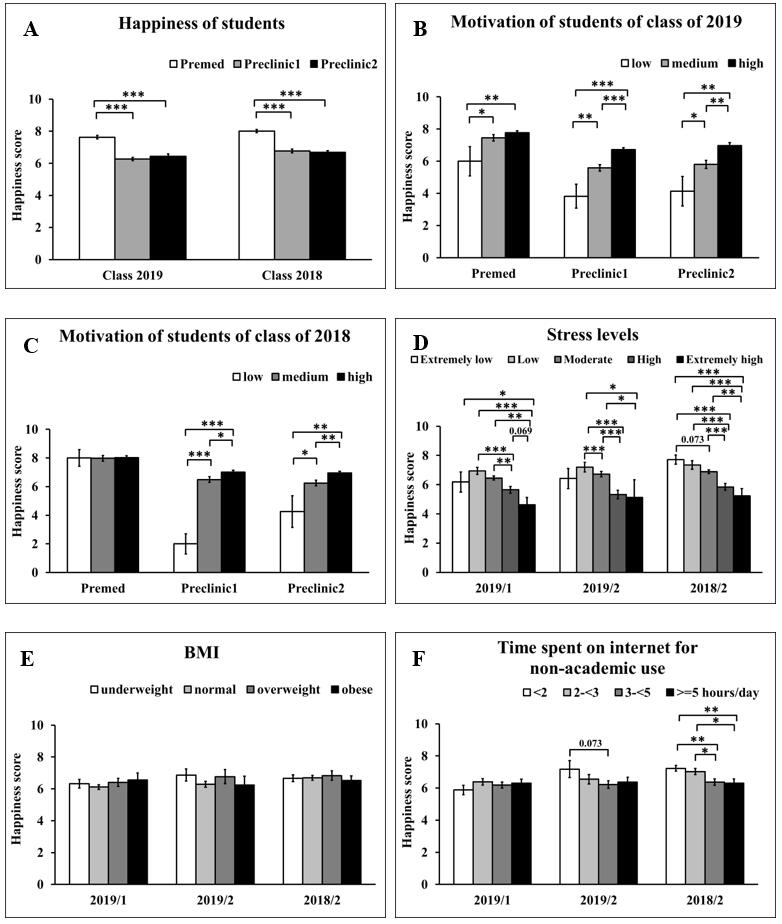Evaluating Factors Influencing Happiness of Preclinical Students
Abstract
This study aimed to determine factors influencing happiness in preclinical students especially in aspects of teaching and learning, students’ motivation, study habits, and academic achievement. This study was a questionnaire-based cross-sectional study. The questionnaire was validated and approved for clarity, readability, rational analysis, and comprehensiveness by the experts. Questionnaires were sent to all second and/or third-year medical students of the 2018 (328) and 2019 (329) classes, Faculty of Medicine Siriraj Hospital, Mahidol University, Thailand. Cronbach’s alpha values were 0.886. The data were analyzed by the Statistical Package for Social Science version 18. From open-ended questions, the top 5 ranking factors increasing students’ happiness were teaching of instructors, content satisfaction, content understanding, free time, and handouts. Factors that had positive influences/associations with happiness of preclinical students were happiness in learning subjects taught in a particular year; satisfaction of content, study outcomes, materials, handouts, teaching motivating desire to learn, and applicability of content to medical profession; high motivation to study medicine, expected score, and the percentage of achievement of study targets; less amount of time spent on recorded-e-lecture study and internet for non-academic use; and low stress. Happiness of preclinical students was influenced by satisfaction in teaching and learning, their attitude, study habits, and academic achievement. Further studies on determining students’ happiness after improvement of teaching and learning environments, augmenting activities that enhance students’ motivation, and promoting good study habits among medical students, are required to prove whether enhancement of these factors could effectively increase students' happiness.
References
Alshehri, A. A., Althobaiti, S. M., Alsaadi, H. D., Alnemari, A. K., Alyami, H., Alyami, M., & Alswat, K. A. (2016). Subjective Happiness Assessment among Taif University Medical Students. American Journal of Educational Research, 4(1), 111-114. https://doi.org/10.12691/education-4-1-17
Bahrami, S., Rajaeepour, S., Rizi, H. A., Zahmatkesh, M., & Nematolahi, Z. (2011). The relationship between students' study habits, happiness and depression. Iranian Journal of Nursing and Midwifery Research, 16(3), 217-221.
Eva, E. O., Islam, M. Z., Mosaddek, A. S., Rahman, M. F., Rozario, R. J., Iftekhar, A. F., Ahmed, T. S., Jahan, I., Abubakar, A. R., Dali, W. P., Razzaque, M. S., Habib, R. B., & Haque, M. (2015). Prevalence of stress among medical students: a comparative study between public and private medical schools in Bangladesh. BMC Research Notes, 8, 327. https://doi.org/10.1186/s13104-015-1295-5
Kjeldstadli, K., Tyssen, R., Finset, A., Hem, E., Gude, T., Gronvold, N. T., Ekeberg, O., & Vaglum, P. (2006). Life satisfaction and resilience in medical school – a six-year longitudinal, nationwide and comparative study. BMC Medical Education, 6(1), 1-8. https://doi.org/10.1186/1472-6920-6-48
Rabito-Alcon, M. F., & Rodriguez-Molina, J. M. (2016). Satisfaction with life and psychological well-being in people with gender dysphoria. Actas Espanolas de Psiquiatria, 44(2), 47-54.
Rahman, N. I. A. R., Ismali, S., Seman, T. N. A. B. T., Rosli, N. F. A. B., Jusoh, S. A. B. M., Dali, W. P. E. W., Islam, M. Z., & Haque, M. (2013). Stress Among Preclinical Medical Students of University Sultan Zainal Abidin. Journal of Applied Pharmaceutical Science, 3(11), 6. https://doi.org/10.7324/JAPS.2013.31113
Raksadawan, Y., Sitticharoon, C., Charoenngam, N., Maikaew, P., & Keadkraichaiwat, I. (2020). Factors Influencing Academic Achievement in Preclinical Students. International Educational Research, 3(3), 8-21. https://doi.org/10.30560/ier.v3n3p8
Sahraian, A., & Vakili, S. M. (2012). Studying the Happiness Level among Medical Students of Shiraz Medical Sciences University in 2010. Shiraz E-Medical Journal, 13(4), 179-186.
Saipanish, R. (2003). Stress among medical students in a Thai medical school. Medical Teacher, 25(5), 502-506. doi:10.1080/0142159031000136716
Sasanpour, M., Khodabakhshi, M., & Nooryan, K. (2012). The Relationship between Emotional Intelligence, Happiness and Mental Health in Students of Medical Sciences of Isfahan University. International Journal of Collaborative Research on Internal Medicine & Public Health, 4(9), 1614-1620.
Slavin, S. J. (2016). Medical Student Mental Health: Culture, Environment, and the Need for Change. The Journal of the American Medical Association, 316(21), 2195-2196. https://doi.org/10.1001/jama.2016.16396
Wongratanacheewin, J., Vimonvanich, S., Teeratakulpisarn, N., Srimanta, N., Pooparadorn, L., Choorus, B., Chitkulsampan, O., Paileeklee, S., & Srisaenpang, S. (2015). The Level of Happiness and Possibly Related Factors among Medical Students of Khon Kaen University 2015. Srinagarind Medical Journal, 30(7), 56.


This work is licensed under a Creative Commons Attribution 4.0 International License.
Copyright for this article is retained by the author(s), with first publication rights granted to the journal.
This is an open-access article distributed under the terms and conditions of the Creative Commons Attribution license (http://creativecommons.org/licenses/by/4.0/).








1.png)

















